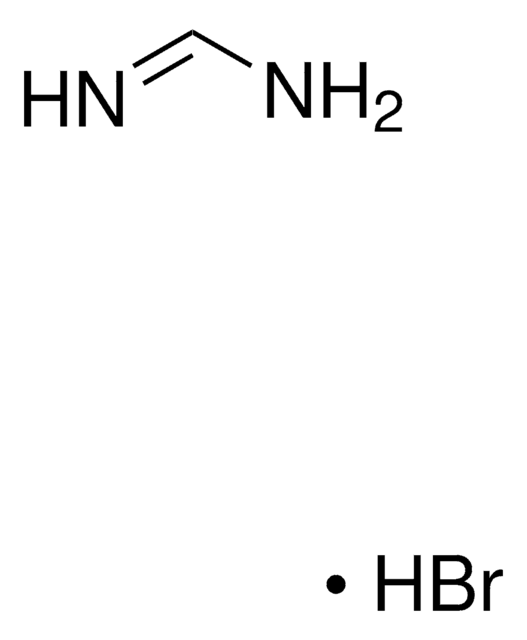203017
Cesium bromide
99.999% trace metals basis
Synonym(s):
Cesium monobromide
Sign Into View Organizational & Contract Pricing
All Photos(2)
About This Item
Linear Formula:
CsBr
CAS Number:
Molecular Weight:
212.81
EC Number:
MDL number:
UNSPSC Code:
12352302
PubChem Substance ID:
NACRES:
NA.23
Recommended Products
Quality Level
Assay
99.999% trace metals basis
form
powder and chunks
impurities
≤15.0 ppm Trace Metal Analysis
mp
636 °C (lit.)
density
4.44 g/mL at 25 °C (lit.)
SMILES string
[Br-].[Cs+]
InChI
1S/BrH.Cs/h1H;/q;+1/p-1
InChI key
LYQFWZFBNBDLEO-UHFFFAOYSA-M
Looking for similar products? Visit Product Comparison Guide
General description
Cesium bromide (CsBr) is an inorganic compound moderately soluble in water and exhibits hygroscopic properties. CsBr crystals are utilized in scintillation counters for detecting radiation due to their effective scintillation properties. It is also used in optics as a beam splitter component in wide-band spectrophotometers.
Application
Cesium bromide can be used as:
- An electrolyte additives to improve the cycling efficiency of lithium and graphite anodes in lithium-ion batteries. The cesium cations can help control the interfacial chemistry on the anode, leading to enhanced performance.
- An additive to enhance the efficiency and stability of CsPbI2Br perovskite solar cells by passivating defects, improving charge transport properties, and contributing to higher power conversion efficiencies.
- As a precursor material to synthesize cesium lead bromide (CsPbBr3) perovskite, which is then utilized as an electrode material in a symmetric supercapacitor.
- As a precursor to prepare thermal neutron imaging plates.
- As a precursor to synthesize lead-free CsBr: Eu2+ nanocrystals for fabricating white LEDs.
- As an additive to prepare CsI-based scintillators. Alloying with cesium bromide increases the yield limit and microhardness of CsI crystals.
Signal Word
Warning
Hazard Statements
Precautionary Statements
Hazard Classifications
Acute Tox. 4 Oral - Aquatic Acute 1 - Repr. 2
Storage Class Code
13 - Non Combustible Solids
WGK
WGK 3
Flash Point(F)
Not applicable
Flash Point(C)
Not applicable
Personal Protective Equipment
dust mask type N95 (US), Eyeshields, Gloves
Choose from one of the most recent versions:
Already Own This Product?
Find documentation for the products that you have recently purchased in the Document Library.
Customers Also Viewed
N Kurata et al.
Radiation protection dosimetry, 119(1-4), 398-401 (2006-06-01)
CsBr phosphor ceramics doped with different luminescence centres such as In2O3, Eu2O3, EuCl3, SmCl3, TbCl3, GdCl3 or NdCl3 as the candidate for a new optically-stimulable phosphor for medical X-ray imaging sensor were prepared using a conventional ceramic fabrication process. It
Peng Pan et al.
Analytical chemistry, 75(20), 5468-5474 (2004-01-09)
Solutions consisting of protein and small molecule mixtures have been subjected to electrospray ionization to study the influence of small molecule/cation components at high concentrations on the electrospray responses of proteins. Emphasis was placed on solutions consisting of equal parts
Matthieu P Wintergerst et al.
Journal of the American Chemical Society, 130(12), 4129-4139 (2008-03-04)
Solvent-extraction studies provide confirming evidence that meso-octamethylcalix[4]pyrrole acts as an ion-pair receptor for cesium chloride and cesium bromide in nitrobenzene solution. The stoichiometry of the interaction under extraction conditions from water to nitrobenzene was determined from plots of the cesium
Caesium-binding sites in the gramicidin pore.
D A Doyle et al.
Biochemical Society transactions, 22(4), 1043-1045 (1994-11-01)
N Devaraj et al.
Analytical biochemistry, 206(1), 142-146 (1992-10-01)
A procedure for the rapid isolation of mucin glycoprotein by density gradient centrifugation in cesium trifluoroacetate (CsTFA) is described. The separation of mixtures of rat tracheobronchial mucin, DNA, hyaluronic acid, and bovine serum albumin in CsTFA gradients was superior to
Our team of scientists has experience in all areas of research including Life Science, Material Science, Chemical Synthesis, Chromatography, Analytical and many others.
Contact Technical Service













